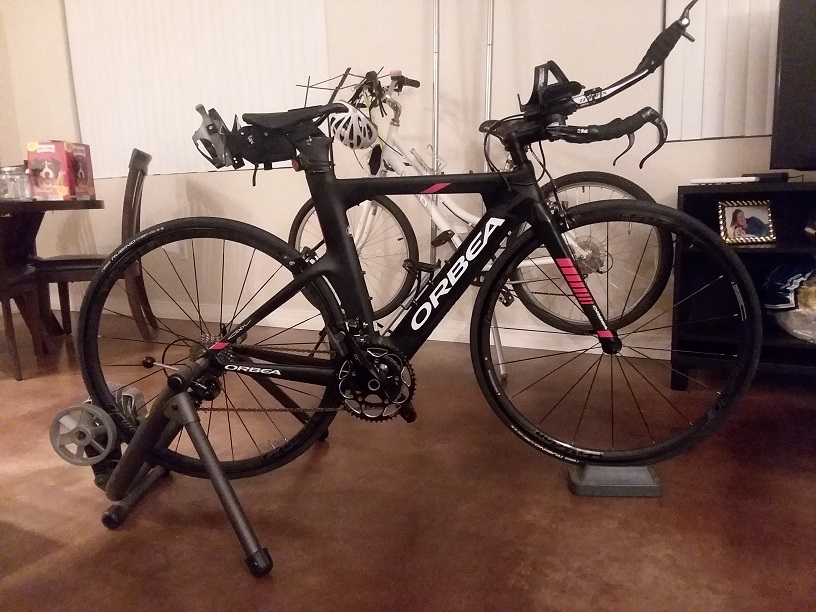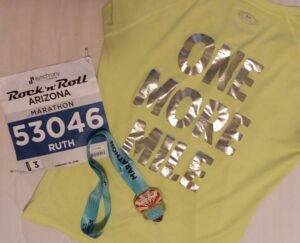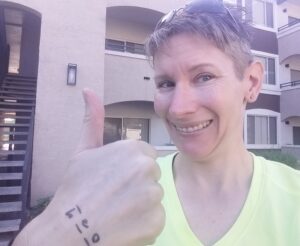My first Half Ironman triathlon is in the books: 70.3 miles in 7 hours, 18 minutes, 25 seconds. I’ll take that.
This race was about a year in the making, ever since I did my first sprint triathlon last September. Less than 30 seconds into that race, I knew the Half Ironman was next.
Getting to Maine
Leading up to Maine 70.3 was training – lots of sweaty training – in the Phoenix heat. I was usually slimy with sweat by Mile 3 of a run, no matter how early I left the house. Coach David and I had to be careful about not having me outside too long on the 110+ degree days.
I also spent the last year dealing with a hip injury. I had to defer both my half marathon and full marathon over the winter because my hip wouldn’t let me train the way I needed to. Thankfully, my physical therapist is also a triathlete, so she was the perfect person to help David and me build up my mileage and adjust my strategy to manage the pain.
Pre-Race Prep
I had many calls and texts with David leading up to race day. We talked about how I was going to fuel during the race with protein powder, gels, and salt. He reviewed my packing list to make sure I brought everything I was going to need. I even made little lists to remind myself of what I needed to do during each transition (swim-to-bike and bike-to-run).
I arrived in Old Orchard Beach, Maine two days before the race. Our hotel was minutes away from the race expo and the starting line. We hit the race expo first to get our race packets (timing chip, race number, bike stickers, swim cap, etc.). I was so jittery-excited I could barely take it all in.
That afternoon, David took me swimming in the ocean. It had been over a year since I’d last swam in an ocean, and it was my first time swimming in my wetsuit. We worked on my form and cadence (which is hard to maintain in choppy water), and he lovingly reminded me of what it’s like to swim in a race by purposely running into me. He calls it Direct Recovery (of) Open Water Navigation (&) Guidance (D.R.O.W.N.G). It sounds cruel, but during a triathlon, people hit and kick you all the time during the swim. It’s better to be ready for it – because it will happen – so it won’t freak you out during the race.
Saturday was all about resting. I think I was the only non-Orthodox Jew in our group. It was fun participating in my first Shabbas lunch and learning all the rules. Since I was the “Shabbas goy†who could do “work,†I walked both David’s and my bikes to the race transition area. He came with me and we timed how long it took to walk from the transition area to the swim start and back to our hotel.
It was windy on Saturday, and David and I talked about what that would mean for my race. I shrugged and said, “I’ll still PR.â€
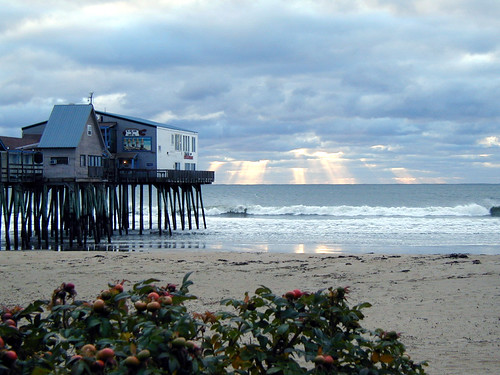
Race Day!
Race day morning was nerve-wracking. I was so nervous/excited as a powered down my oatmeal, pulled my wetsuit halfway up my body, and packed my gear bag for the race. David was cool as a cucumber as I was powerwalking to bike transition area, afraid I wouldn’t have enough time to lay out my gear before we had to report to the beach for the swim. (We had plenty of time.)
1.2-Mile Swim in the Atlantic Ocean
For the start of the race, we lined up based on when we expected to finish the swim. Instead of going in all at once, the organizers had us going in four swimmers at a time, each group five seconds apart.
Even though David is a faster swimmer than me, he lined up with me so he could be there to give me a last hug and be the proud coach to who told the announcer that it was my first Half Ironman. We walked into the ocean together, and within minutes we were apart, swimming our own races as we expected.
The swim was brutal. The water was cold and choppy. I had so much adrenaline coursing through my veins that I didn’t feel cold, but it was cold enough that the race was “booties legal†(below 65 degrees). Even though I was wearing goggles, I could barely see anything underwater, except the air bubbles coming out of my mouth. I couldn’t even see the hands and feet that were coming towards me until right before they hit me in the face. With 2,400+ racers, I got hit a lot.
The race route was a rectangle – out, over, and back again. Throughout the route, there were volunteers on paddle boards and kayaks where you could grab on if you needed a minute to rest and breathe. I checked my watch when I grabbed onto the first kayak – 4:45 into the race. I was panicking. I couldn’t find my cadence and I it seemed like I was getting hit by the other racers every few seconds.
There were three other racers holding onto the kayak. We gave each other a few encouraging words before letting go to swim on.
At the buoy signaling the last turn for shore, I began to get pulled off course. In my wetsuit, I was essentially a floaty on top of the water, being pulled by the sideways current. A paddle boarding volunteer caught up with me and told me to aim back towards to race route. I tried, but it didn’t work. I was too tired and too light to get back to the group. Instead, I aimed for shore and walked back when my feet hit the sand.
One of the challenges of Ironman is you’re stuck listening to your own thoughts for the entire race. (No earbuds or cell phones allowed.) I kept myself going with words of encouragement using “Baby Duck,†my gymnastics coach’s pet name for his gymnasts.
I was so tired after the swim. I finished it in 1 hour, 2 minutes – 12 minutes longer than I wanted – and because I got pulled so far off course, I ended up doing 2,800 yards (including my walk back) instead of 2,100.
As I walked back to the official swim exit, I saw two lifeguards carrying a swimmer out of the water because they were too tired to walk. After the race, I heard a rumor that 70 people didn’t finish either because they were too tired or got seasick.
Transition One: Swim-to-Bike
As I walked over the sensor that indicated that I finished the swim, I said, “Fuck Ironman†and flipped off the photographer getting shot of all of us coming out of the swim. I was so tired and angry. That’s also when I finally felt how cold I was.
At the end of the swim, there were volunteers called “strippers†who peeled off our wetsuits. As I walked up to them, I said, “Who wants to touch me?†Two women held up their hands to help me. They pulled off my wetsuit and handed it to me to carry back to the bike transition.
Once I got to my bike, I pulled off my swim cap and googles, sprayed down with sunblock, put on my socks, bike shoes, bandana, helmet, and sunglasses, and I was off again.
56-Mile Bike Ride
The bike ride took us through the back roads of many towns in the area. I loved that this bike route was a single loop rather than several laps on a smaller loop.
Near the beginning of the ride, I saw a street called Ruth Way. I smiled and thought, “My race. My way.â€
This area of Maine is gorgeous – lots of houses with barn stars (for good luck), cows, big trees, and open pastures. The route had rolling hills, and only a few were brutal. It was much nicer than city riding.
Throughout the ride, I found people to pace with – we learned each other’s names and said hello as we passed each other. I was pleased to see that I frequently passed people, especially on the hills. As I climbed each hill, I muttered, “We train on hills because we race on hills.†It felt gratifying to pass other people in my division. (The organizers write your age on the back of your left calf in black marker before the beginning of the race.)
There were three aid stations along the ride that had bananas, water, and Gatorade. I came to a full stop at each one to have a banana and switch out my Gatorade bottle. I was like a Minion, smiling, and saying, “Mmm, banana†each time. Most of the other racers near me could grab and consume these without falling. I wasn’t that skilled yet.
Based on our training rides, I knew there was a chance I’d catch up to David during the bike. I passed him at Mile 36. He was unmistakable with his tzitzit and his neon yellow “Do Epic Shit†socks. I was impressed when he passed me just before the end of the ride. We finished with only two riders between us.
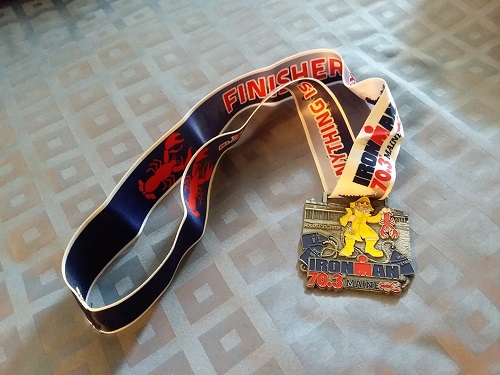
Transition Two: Bike-to-Run
I made sure I did three things before I headed out for the run:
- My shoes were tied the way I like them.
- I sprayed my skin with sunblock again.
- I put on my hat.
Even though we were in Maine, I didn’t want to finish the race looking like a lobster.
David is much faster in the transitions than I am. (He’s done 6 Ironman and more than 20 Half Ironman races.) By the time I got out on the run, he was already about three minutes ahead of me.
13.1-Mile Run
I felt better than I expected during the run. I’ve heard that some racers have to walk the first part of the run until they get their “legs back.†I could run from my first step. I wasn’t fast, but I was running. Actually, I was surprised by how many people I passed during the run portion.
The race organizers had aid stations every 1 to 1.5 miles along the route with Gatorade, water, Coke, bananas, oranges, and pretzels. I stayed hydrated with Gatorade, treated myself to Coke twice, and gave myself hits of salt from a race vial that I was carrying with me.
About a third of the run was on a nature trail. Anyone who knows me knows that I don’t like trail running. I’m clumsy enough without outside help. I caught up with David around Mile 4, while we were on the trail. As I approached him, I said, “Fuck you, David,†and he responded, “That’s my athlete.†He “forgot†to tell me that part of the race was on dirt. I passed him and kept going. (He and I have a running joke about cursing his name.)
My strategy for the run was to alternate between running and walking. I started with run 9 minutes/walk 1 minute. At minute 58 of my run, my hip started to hurt, so I shifted to run 6/walk 1.
Crossing the Finish Line
I ran as hard as I could for the last half mile of the race – pushing myself for a strong finish. I raised my arms triumphantly as I crossed the finish line. To be honest, I was so tired, I was surprised I could still lift my arms.
I hung out in the finish line area, knowing David wasn’t far behind me. He crossed the finish line five minutes after me and gave me a big hug. He was beaming with coach pride.

Post-Race
It felt so good to step into a hot shower after the race. I was covered in salt, sweat, and sunblock.
The next morning, I flew home to Phoenix. I was tired and sore, but thankfully, the pain was nothing like I feared.
So many thanks to Ironman, the volunteers, everyone who cheered along the race route, all my loved ones who supported me in this journey, and especially Coach David and his family. I couldn’t have done this without you.
